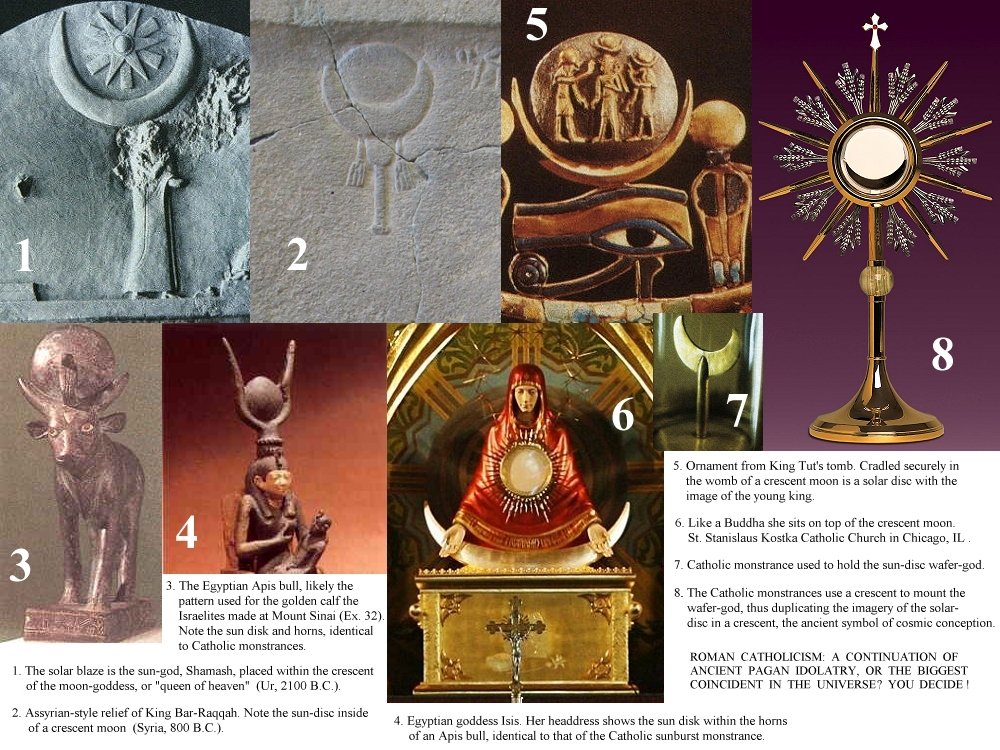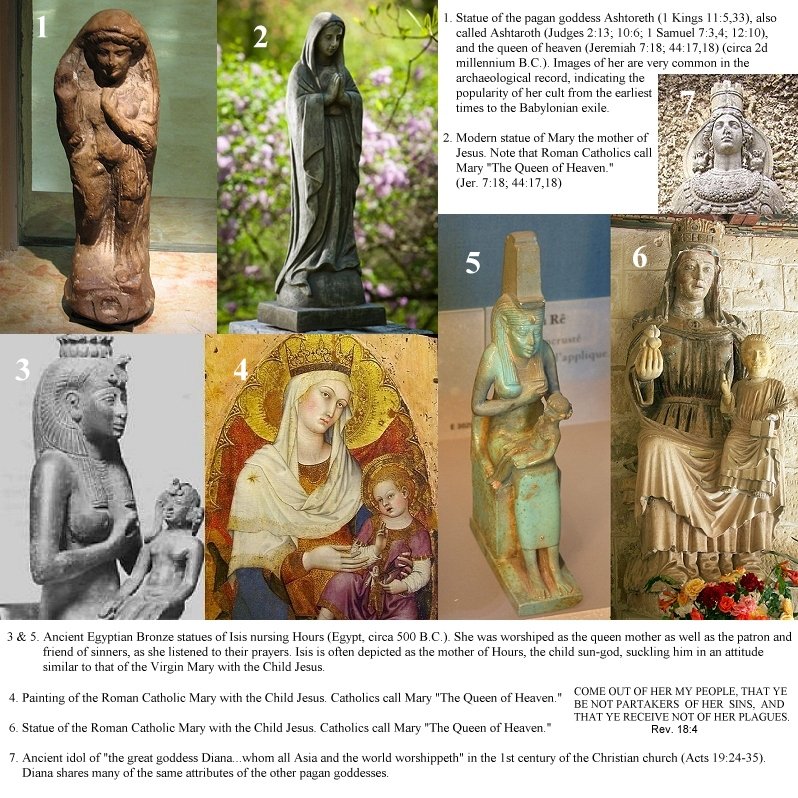|
In biblical times idols were made in different ways and of various materials. Judges 17:3 speaks of "a carved image and a molded image." Some were made of metal or wood, and others were poured into a mold or shaped by hand. The silver or gold idols were poured, but the clay ones could also be shaped by hand. The image in Nebuchadnezzar's dream (Dan. 2:3,23-33) was of gold, silver, bronze, iron, and clay. |
|
|
In a satire on idolatry, the prophet Isaiah provided considerable detail about the making of idols (Is. 44:9-20). He described the smith with his tongs and hammer and the carpenter with his ruler, line, planes, and compass. Isaiah also ridiculed the idol-makers by noting that such a statue has to be nailed down "that it should not be moved" ["that it might not totter"] (Is. 41:7). |
|
|
Perhaps the best definition of an idol is something we ourselves make into a god. It does not have to be a statue or a tree. It can be anything, or anyone, that stands between us and God or something we substitute for God. |
|
| IDOLATRY -
-1) the worship of something created as opposed to the worship of the Creator Himself. -2) the worship, veneration, devotion or reverence of someone or something created as opposed to the worship of the Creator, or in addition to the worship of the Creator. Scores of references to idolatry appear in the Old Testament. This shows that idolatry probably was the greatest temptation our spiritual forefathers faced. While we find bowing down to a statue no temptation, they apparently slipped into idolatry constantly. So serious was this sin that the prohibition against the making and worshiping of images was included as the second of the Ten Commandments (Ex. 20:4-6). |
|
|
Israel's ancient neighbors believed there were many gods. They worshiped whatever gods were necessary at a given time. An equally erroneous notion was that these gods either were idols themselves or were represented by idols. Some people probably insisted that the idol was only an aid to worship and not the object of worship itself. But this distinction must have been hard to keep in mind. That is why the Bible strictly forbids the making of images of any kind -- a worship which God jealously reserves for Himself. |
|
|
Archaeologists have discovered idols of most of the pagan gods mentioned in the Bible, in addition to many unidentified ones. Since the Romans began emperor worship late in the New Testament period, some of the elegant statues of the Caesars discovered by archaeologists must have been idols to be worshiped. |
|
|
Idolatry can take many forms, and it has persisted from the earliest times. Joshua 24:2 states that Abraham's father served idols. Perhaps the earliest reference in the Bible to idols is the "household idols" or TERAPHIM (small clay figurines) which Rachel stole from her father Laban (Gen. 31:34). |
|
|
The next noteworthy instance of idolatry was Aaron's making of the golden calf at the foot of Mount Sinai. This happened when the Israelites lost their patience waiting for Moses to return with the revelation of the true and living God (Ex. 3:1-4). Some have tried to defend Aaron's action by saying that the calf was merely the seat which the invisible God occupied. Certainly Moses did not understand idolatry that way. The incident at Baal of Peor (Num. 25:1-3) also involved the worship of an idol. |
|
|
The conquest of Canaan by the Hebrews brought new temptations to worship the object created rather than the Creator. Joshua 24:15 poses the classic question: Whom will you serve? The gods of Egypt where you have lived? The gods of the Amorites where you now dwell? Or Jehovah the God of Israel? As always, some made the wrong choices (Judges 17-18). A man made an idol for his personal use, but the tribe of Dan took it over for their own use. The Bible does not indicate what shape that statue was in or what god it represented. |
|
|
Others tried the route of compromise: the mixing of idolatry with worship of the true God. So Gideon's ephod was made an object of worship (Judg. 8:24-27). Much later there was another instance of an otherwise good symbol of God's deliverance turned into an idol. In King Hezekiah's time the people worshiped Moses' bronze snake (Num. 21:9; II Kings 18:4). |
|
|
While idolatry was held in check during most of the period of the United Kingdom under David and Solomon, it burst forth again after the separation of the Israelites into two nations in 922 B.C. In fact, Jeroboam made two calf idols and installed them at the major cities in the north and the south (Dan and Bethel) for the purpose of keeping his people's religious allegiance within the borders of the new kingdom (I Kings 12:27-30). He was afraid if they returned to Jerusalem they might also return to the Lord, and that would spell political disaster for him. |
|
|
All the successive monarchs in the northern kingdom of Israel were bad. Invariably their sin involved idolatry. Starting with Elijah, the prophets called on the people to turn from the worship of false gods back to reverence for the true God. Hosea's entire book is devoted to preaching against idolatry. Under the figure of speech of divorcing the Lord and marrying Baal, he tied together the ideas of idolatry, spiritual adultery, and literal adultery (Hos. 2:2; 4:2, 13; 7:4; 8:5; 13:2). |
|
|
Although there were some good kings in the southern kingdom of Judah, the bad ones invariably fell to idolatry. This prompted the major prophets -- Isaiah, Jeremiah, and Ezekiel --and most of the minor prophets as well to ridicule, condemn, and warn against idolatry. A sampling of courageous declarations from these courageous preachers would include Isaiah 2:8; Jeremiah 50:2; Ezekiel 6:4-6; Micah 1:7; Habakkuk 2:18; and Zechariah 13:2. |
|
|
In the gospels there is virtually nothing about idolatry, but in the letters of Paul and the other New Testament books Christians are frequently warned against idolatry. The Christians lived in a world filled with idols. Both the Romans and the Greeks used them. Paul's observation about Athens in Acts 17:16 tells it well: "He saw that the city was given over to idols." |
|
|
In the New Testament period the term idolatry began to be used as an intellectual concept. Idolatry became not the actual bowing down before a statue but the replacement of God in the mind of the worshiper. Colossians 3:5 points in this direction: "Put to death...covetousness, which is idolatry." (See also Eph. 5:5.) At this point the modem believer must understand the vicious nature of idolatry. While we may not make or bow down to a statue, we must be constantly on guard that we let nothing come between us and God. As soon as anything does, that thing is an idol. |
|
|
In addition to material objects such as houses, land, and cars, idols can be people, popular heroes, or those whom we love. Objects of worship can even include things like fame, reputation, hobbies, pride, and deeds done in the name of the Lord. Idolatry is a dangerous and deceitful sin. No wonder prophets preached against it so often and so strongly. |
|
EXODUS 20:3-6
Thou shalt have no other gods before me.
Thou shalt not make unto thee any graven image, or any likeness of any thing that is in heaven above, or that is in the earth beneath, or that is in the water under the earth:
Thou shalt not bow down thyself to them, nor serve them: for I the LORD thy God am a jealous God, visiting the iniquity of the fathers upon the children unto the third and fourth generation of them that hate me;
And shewing mercy unto thousands of them that love me, and keep my commandments. |
|
|
In ancient times God allowed his people to go astray and worship in the idolatrous ways of the nations of the world (Deut. 4:19; 17:3; Judges 2:13; 10:6; I Sam. 7:3,4; 12:10; I Kings 11:5,33; II Kings 23:3-5,13; Jer. 7:18; 44:17,18). And the New Testament makes it clear that God will allow his people to go astray today. Ancient sun-worship was an idolatrous custom of the nations of the world from the earliest times of recorded history. Ancient celestial deities were worshiped under a variety of names, but they all shared identical or similar attributes. The Scriptures record numerous instances when God's people turned to pagan idolatry; “and they worshipped the sun” (Ezek. 8:16); “the queen of heaven” (Jer. 7 & 44); etc. (Judges 2:13; 10:6; I Sam. 7:3,4; 12:10; I Kings 11:5,33; II Kings 23:13; Ezek. 8:13-16). When God delivered the children of Israel from bondage in Egypt, many of his people yearned for the idols of the pagan gods (Ezk. 20:1-16). The book of Acts says of God's own people, even after he delivered them from bondage in Egypt, “in their hearts turned back again into Egypt,...Then God turned, and gave them up to worship the host of heaven;” (Acts 7:39-43). Click thumbnails below to see images comparing the striking similarities between the various ancient and modern idolatries:
“they worshipped
the sun” (Ezek. 8:16) |
 |
|
“burn[ed] incense unto the
queen of heaven” (Jer. 44:17) |
 |
|
“Now all these things happened unto them for ensamples: and they are written for our admonition, upon whom the ends of the world are come.” (I Cor. 10:11)
|
|
|
“And the word of the LORD came unto me, saying, Son of man, these men have set up their idols in their heart, and put the stumblingblock of their iniquity before their face: should I be enquired of at all by them? Therefore speak unto them, and say unto them, Thus saith the Lord GOD; Every man of the house of Israel that setteth up his idols in his heart, and putteth the stumblingblock of his iniquity before his face, and cometh to the prophet; I the LORD will answer him that cometh according to the multitude of his idols; That I may take the house of Israel in their own heart, because they are all estranged from me through their idols. Therefore say unto the house of Israel, Thus saith the Lord GOD; Repent, and turn yourselves from your idols; and turn away your faces from all your abominations. For every one of the house of Israel, or of the stranger that sojourneth in Israel, which separateth himself from me, and setteth up his idols in his heart, and putteth the stumblingblock of his iniquity before his face, and cometh to a prophet to enquire of him concerning me; I the LORD will answer him by myself: And I will set my face against that man, and will make him a sign and a proverb, and I will cut him off from the midst of my people; and ye shall know that I am the LORD. And if the prophet be deceived when he hath spoken a thing, I the LORD have deceived that prophet, and I will stretch out my hand upon him, and will destroy him from the midst of my people Israel. And they shall bear the punishment of their iniquity: the punishment of the prophet shall be even as the punishment of him that seeketh unto him; That the house of Israel may go no more astray from me, neither be polluted any more with all their transgressions; but that they may be my people, and I may be their God, saith the Lord GOD.” (Ezekiel 14:2-11)
|
|
|